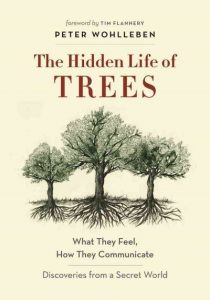I first mentioned my current obsession with trees here. Please, allow me to continue to ramble on. My current WIP takes place in a dense forest, similar to or based on the dense forests in southwest Germany or the Alsace region of France. The story is fairy tale-like, evoking (I hope) the magical forests of classic fairy tales. Trees shelter and protect characters in danger, they warn of intruders, they supply needed medicines, and generally act as a force for good for all the forest inhabitants.
Then, I came across this delightful book: The Hidden Life of Trees: What They Feel, How They Communicate, by Peter Wohlleben. This is not a case of life imitating art, but surpassing it. This is a case of truth being equal to or better than fiction. Turns out, trees found in dense natural forests really do all those things, at least for each other.
Wohlleben manages forests in Germany, and he writes with great affection of trees interconnected with one another through their root systems, sharing nutrients, supporting and nurturing sick trees back to health, even supplying nutrients to a seemingly dead stump. He tells of trees releasing toxic substances to deter pests, then other trees reading the situation and releasing their own toxic substances. Trees are communicating with one another for the good of the entire population, they work together to establish a local climate or ecosystem in which they all benefit. Overall, he sees a group of related trees functioning as a single unit, much like an ant colony.
Other topics include the maternal instinct of some trees, who actually slow the growth of young trees, because a slower growth is associated with longevity, the interaction between trees and other organisms such as mosses, birds, or ivy, and how trees recovery from injury. Time is measured differently for trees, with units of decades or even centuries, rather than hours or days. The dramas that unfold in a tree’s life cycle unfold very slowly.
One of the author’s main points in that though these helpful communications and adaptations are found in natural forests, they are reduced in many of our planted or cultivated forests and completely absent when trees are artificially planted by humans for landscaping or other purposes. Without their companions, the utilization of resources is changed which alters growth patterns. Their ability to recover from injury or illness is harmed, and overall we see a decrease in life span. Wohlleben’s message is clear: we destroy natural forests at our own peril and to the detriment of these wonderful species.
If you had told me ten years ago that I would be reading a non-fiction book about tree communication and loving it, I would have laughed out loud. It is a testament to Wohlleben’s infectious love for his subject, his approachable writing style, and the general fascination of the science.
So, am I justified in my imagined tree-characters in my WIP? I’ll leave you with Wohlleben’s final sentences:
Under the canopy of the trees, daily dramas and moving love stories are played out. Here is the last remaining piece of Nature, right on our doorstep, where adventures are to be experienced and secrets discovered. And who knows, perhaps one day the language of trees will eventually be deciphered, giving us the raw material for further amazing stories. Until then, when you take your next walk in the forest, give free rein to your imaginations – in many cases, what you imagine is not so far removed from reality after all!

























